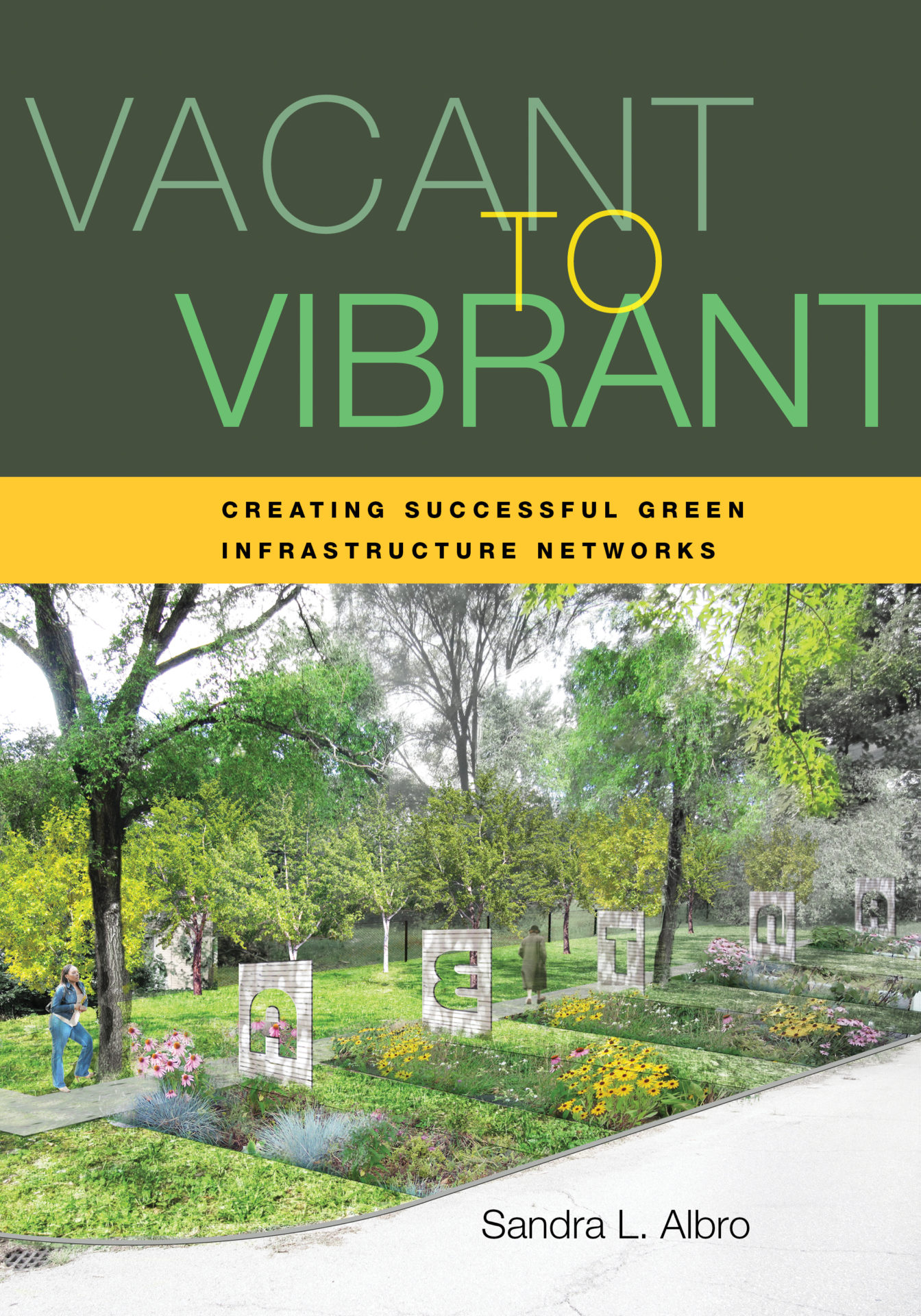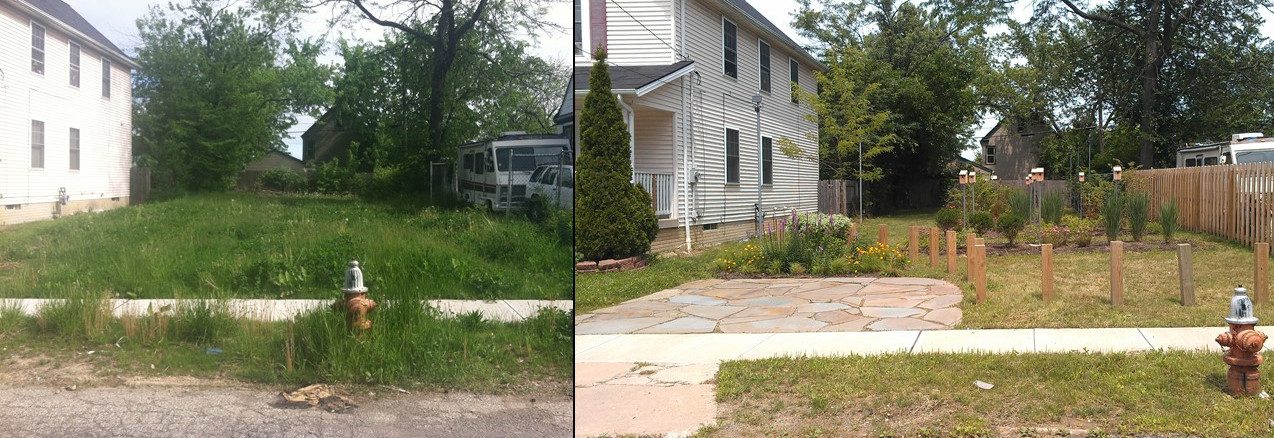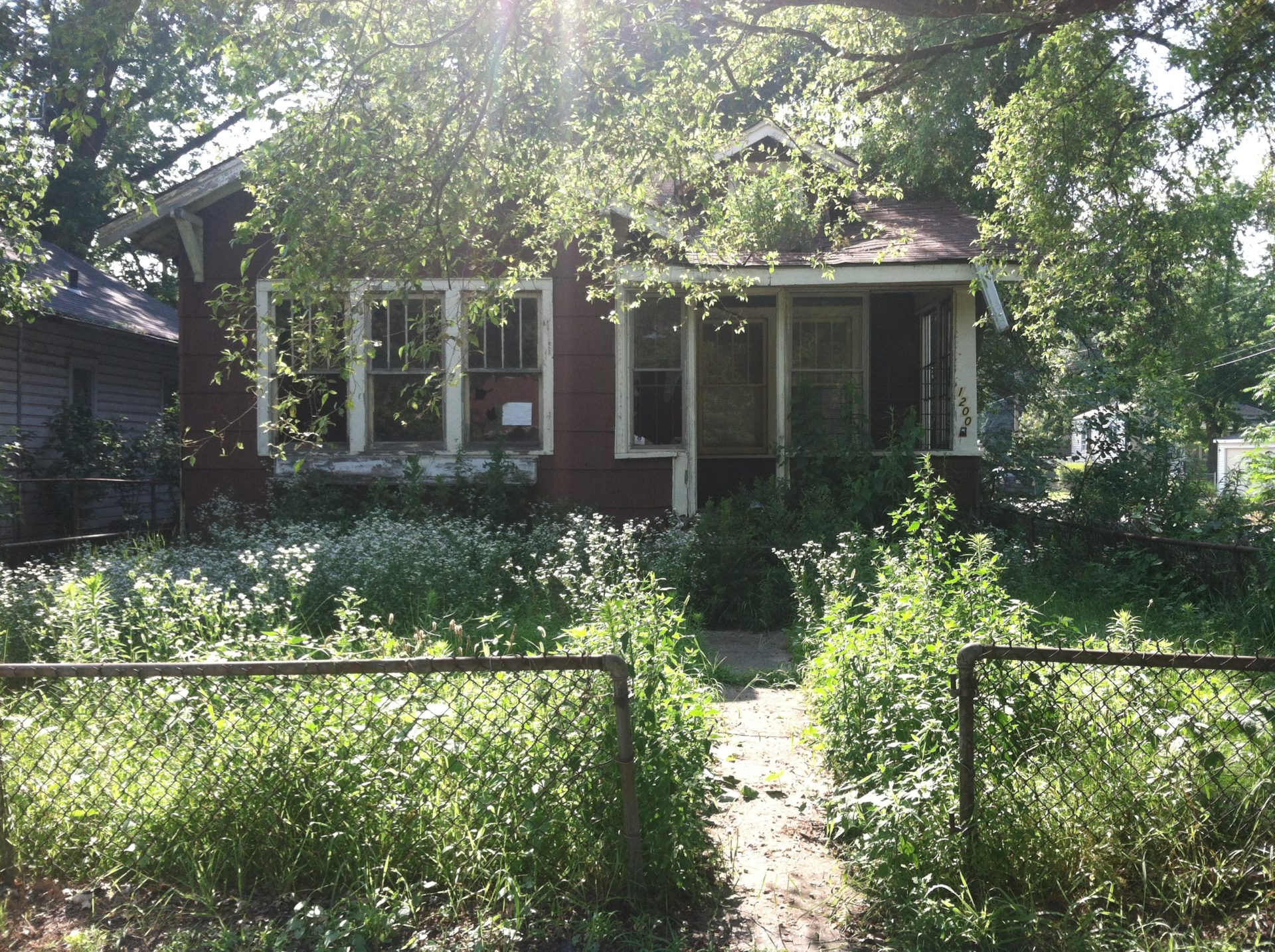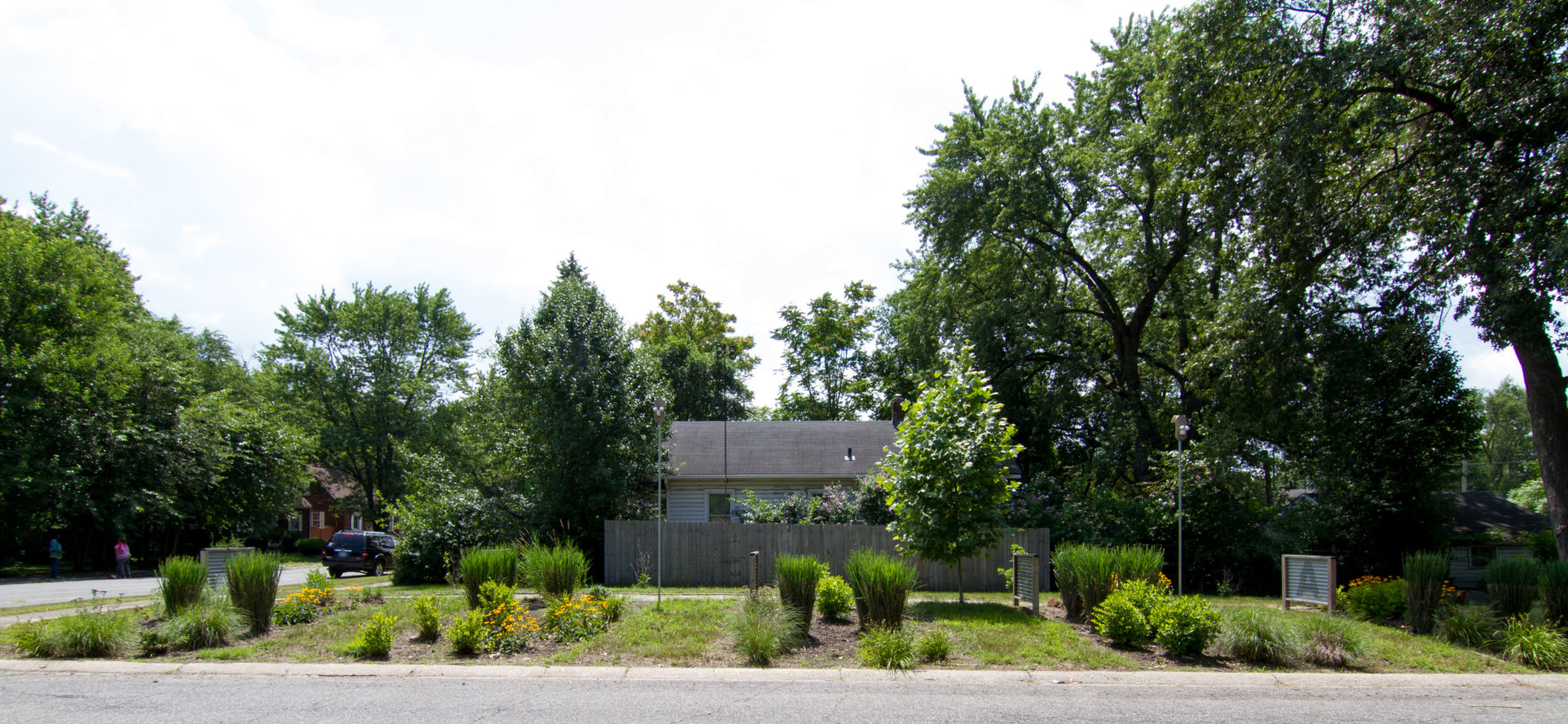From Vacant to Vibrant by Sandra L. Albro. Copyright © 2019 by the author. Reproduced by permission of Island Press, Washington, D.C.
by Sandra Albro
 In this adapted excerpt from Vacant to Vibrant: Creating Successful Green Infrastructure Networks (Island Press, 2019), author Sandra Albro shares lessons from a multidisciplinary project team that built nine green stormwater parks on small vacant lots in three post-industrial cities—Gary, Indiana; Cleveland, Ohio; and Buffalo, New York. The project, “Vacant to Vibrant,” replicated similar processes across three Great Lakes states with the goal of discerning site-specific considerations from more generalizable lessons.
In this adapted excerpt from Vacant to Vibrant: Creating Successful Green Infrastructure Networks (Island Press, 2019), author Sandra Albro shares lessons from a multidisciplinary project team that built nine green stormwater parks on small vacant lots in three post-industrial cities—Gary, Indiana; Cleveland, Ohio; and Buffalo, New York. The project, “Vacant to Vibrant,” replicated similar processes across three Great Lakes states with the goal of discerning site-specific considerations from more generalizable lessons.
Low Maintenance Is Not Low Value
A challenge of promoting low-maintenance, ecologically friendly landscapes in urban areas is that such landscapes are perceived to have inherently low social and economic value. This is for two reasons. First, maintenance requirements can be an indication of wealth and status, so higher-maintenance landscapes are often perceived to be more desirable.[i] Consider a golf course or a royal garden: We perceive these landscapes to be aesthetically pleasing, in part, because of the resources required to cultivate their uncommonness—strange plants in strange shapes in incongruent places. The ability to sustain them conveys wealth and prestige. On a more modest scale, a turf lawn—green and weed free—communicates that the home owner has the time and resources to cultivate a space that is very different from what would grow spontaneously.
Secondly, few people factor ecological health into their perception of landscape value.[ii] Americans are, in general, very poorly educated about plants, which leads to the inability to notice them in our landscape, a phenomenon known as “plant blindness.” People who have not had formal training in plants tend to not notice indicators of lower ecological integrity, such as invasive species, low biodiversity, or signs of past human disturbance. Urban dwellers may even prefer landscapes with low ecological integrity—see, again, monoculture lawns. Look, too, at the limited palette of commonly used landscaping plants (hostas, azaleas, roses) compared to the wide range of options that are available.

Children swing at a Vacant to Vibrant pocket park site in Cleveland.
More ecologically minded folks can forget how common plant blindness is. In a land of golf courses and turf lawns, patches of native prairie are alien. However, the negative perceptions of intentionally low-maintenance landscapes—that they are weedy, ugly, and an indicator of disinvestment—are not inconsequential. While tidier urban greening practices have been shown to lower stress and raise property values, unkempt vacant lots have the opposite effect.[iii],[iv] The negative social and economic effects that vacant unkempt lots have on neighborhoods directly result from the value that we attach to maintenance requirements and appearance.
In urban neighborhoods that have long suffered the consequences of disinvestment, there are ethical considerations for creating landscapes that convey lack of care, even unintentionally. In general, if a landscape practice would not be tolerated by residents of wealthier, more stable neighborhoods where it would be less likely to cause measurable negative effects on property values, it is arguably unethical to construct them in areas that are more vulnerable to these negative impacts.

A Cleveland vacant residential lot (left) chosen for a native plant garden, before construction. The finished plant garden (right), with birdhouses in beds of native flowers, was designed to beautify the neighborhood and provide a space for quiet reflection.
This is not to suggest, however, that low-maintenance urban greening practices should not be built in disinvested neighborhoods where they are most needed—in fact, we located Vacant to Vibrant within neighborhoods that could benefit from the stabilizing effects of urban greening. Instead, in the interest of building low-maintenance urban green spaces in an ethical manner, we can design them in a way that makes them appear intentional and tidy and that is sensitive to local cultural norms. Over time, such projects can cultivate broader acceptance of low-maintenance landscapes and close the gap between ecological value and aesthetic value.
Shifting Public Opinion About Low-Maintenance Urban Landscapes
Academic literature suggests three ways to bring aesthetic value and ecological function of landscapes into closer alignment: educational campaigns, good design practices, and making use of early adopters to shift public perception.[v],[vi] Urban greening practitioners tend to focus on education, believing that by simply telling the story of how rain gardens clean water and provide habitat, residents will overcome their aesthetic distaste. While education can increase resident preference for ecologically friendly landscapes,[vii] it is usually not the most effective way to shift cultural norms toward more eco-friendly practices.

This house in Gary, located on a prominent corner in the Aetna neighborhood, had stood vacant for 15 to 20 years prior to Vacant to Vibrant.
Good design can convey care and intentionality, such as through the use of tidy borders, which increase tolerance for the untidy spaces within them[viii]. A tidy border can be a mown strip, possibly with the addition of a simple fence (as in the Philadelphia LandCare program). In Vacant to Vibrant, we experimented with several types of low-cost, decorative fencing, including cable fences, zig-zag chain link, and bollard fences. To reduce fence upkeep and grow urban tree canopy, Cleveland and Detroit are using living bollard fences composed of trees planted in a row.

In the finished project site, visitors are welcomed to Aetna by five letter signs that spell out the name of the neighborhood. Each letter sign sits within a small rain garden. Credit: Cooley’s Video.
And in Buffalo, People United for Sustainable Housing (PUSH) found ways to create a tidy appearance while also easing maintenance requirements: limiting the number of plant species used;, grouping individual species into rows or clumps; and keeping plants spaced apart in a bed of composted wood mulch. In this way, PUSH made use of native plants that may be perceived to be weedy in other contexts, but in a manner that still conveyed that the space was being maintained. It carried the additional benefit of being easier for maintenance crews to distinguish desired native plants from weeds in late spring when plants were reemerging from winter dormancy.

A small vacant parcel (left) sat at a street corner in a mixed-use neighborhood on Buffalo’s West Side. The completed corner park (right) adds pervious off-street parking, a bench, and a small rain garden that collects stormwater from the roofs of two adjacent houses.
Lastly, there is evidence that the biggest effect on resident behavior is the actions of their neighbors. Neighbors have been found be highly influential on topics as wide-ranging as lowering household energy consumption,[ix] displaying political yard signs,[x] or tolerating eco-friendly landscapes.[xi] Early adopters of sustainable land use practices can serve as ambassadors to shift public opinion over time. For practitioners, cultivating relationships with willing neighbors is as important as trying to sway public opinion through educational campaigns. The Vacant to Vibrant project greatly benefitted from the involvement of community liaisons who were already known within our target neighborhoods and who were supportive of the goals of our project. These liaisons were able to bridge gaps in trust and understanding between the project team and local residents. They helped enlist key neighbors in conversations about design, function, and maintenance that were key to the success of our urban green spaces over the seven-year duration of the project.
In the long term, scaling up green infrastructure will require ongoing community engagement to infuse more considerations for ecological health into resident preferences for urban landscapes, while also ensuring that urban greening practices work in service of existing communities by reflecting their values and culture.
About the Author
As director of community partnerships at Holden Forests & Gardens, Sandra Albro works to connect local communities to the wonder, beauty, and value of trees and plants. Her areas of expertise are in collaborative urban greening and vacant land use as tools for community health and revitalization. She was project manager for “Vacant to Vibrant”, an urban greening initiative in three Great Lakes cities, and is author of the book, Vacant to Vibrant: Creating Successful Green Infrastructure Networks (Island Press, 2019).
References
[i] Joan Iverson Nassauer, The Aesthetics of Horticulture: Neatness as a Form of Care (Alexandria, VA: American Society for Horticultural Science, 1988).
[ii] Gobster, Paul H., Joan I. Nassauer, Terry C. Daniel, and Gary Fry. “The shared landscape: what does aesthetics have to do with ecology?.” Landscape ecology 22, no. 7 (2007): 959-972.
[iii] Branas et al., “A Difference-in-Differences Analysis of Health, Safety, and Greening Vacant Urban Space”.
[iv] Eugenia Garvin, Charles Branas, Shimrit Keddem, Jeffrey Sellman, and Carolyn Cannuscio, “More Than Just an Eyesore: Local Insights and Solutions on Vacant Land and Urban Health,” Journal of Urban Health 90, no. 3 (2013): 412–426.
[v] Gobster et al., “The Shared Landscape”.
[vi] Joan Iverson Nassauer, Zhifang Wang, and Erik Dayrell, “What Will the Neighbors Think? Cultural Norms and Ecological Design,” Landscape and Urban Planning 92, no. 3–4 (2009): 282–292.
[vii] Shari L. Rodriguez, M. Nils Peterson, and Christopher J. Moorman, “Does Education Influence Wildlife Friendly Landscaping Preferences?” Urban Ecosystems 20, no. 2 (2017): 489–496.
[viii] Nassauer, The Aesthetics of Horticulture: Neatness as a Form of Care.
[ix] P. Wesley Schultz, Jessica M. Nolan, Robert B. Cialdini, Noah J. Goldstein, and Vladas Griskevicius, “The Constructive, Destructive, and Reconstructive Power of Social Norms,” Psychological Science 18, no. 5 (2007): 429–434.
[x] Todd Makse and Anand E. Sokhey, “The Displaying of Yard Signs as a Form of Political Participation,” Political Behavior 36, no. 1 (2014): 189–213.
[xi] Larissa Larsen and Sharon L. Harlan, “Desert Dreamscapes: Residential Landscape Preference and Behavior,” Landscape and Urban Planning 78, no. 1–2 (2006): 85–100.

